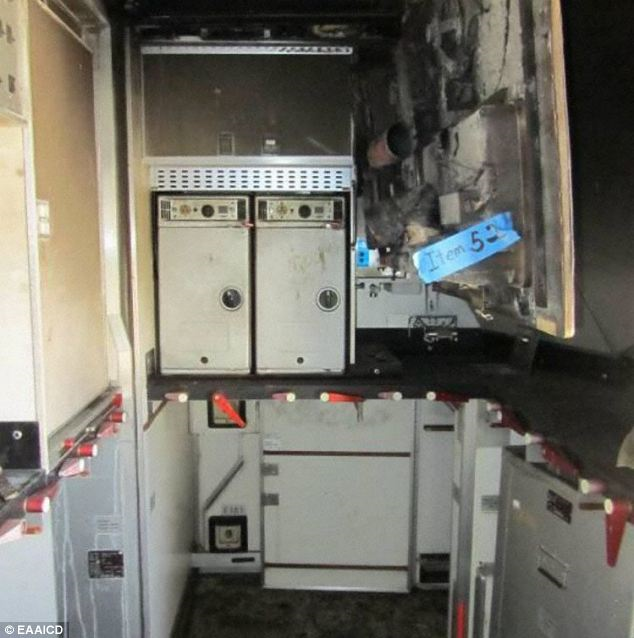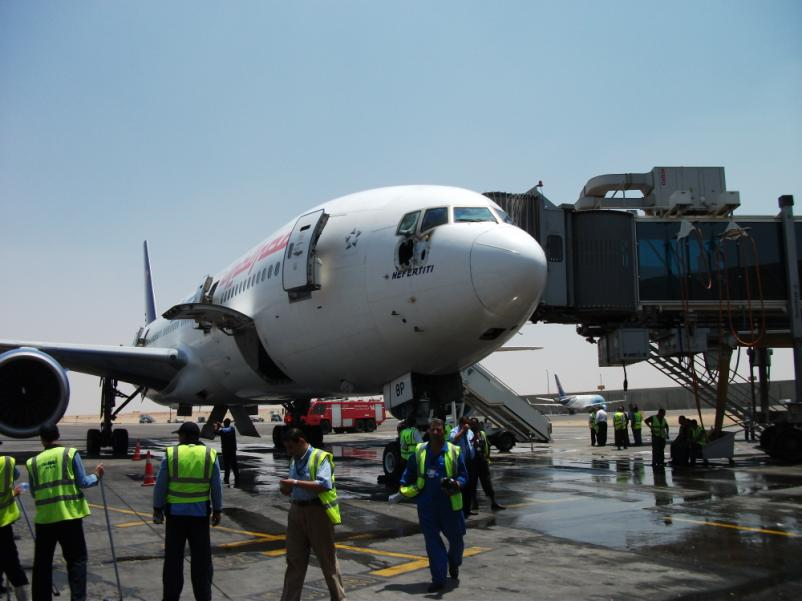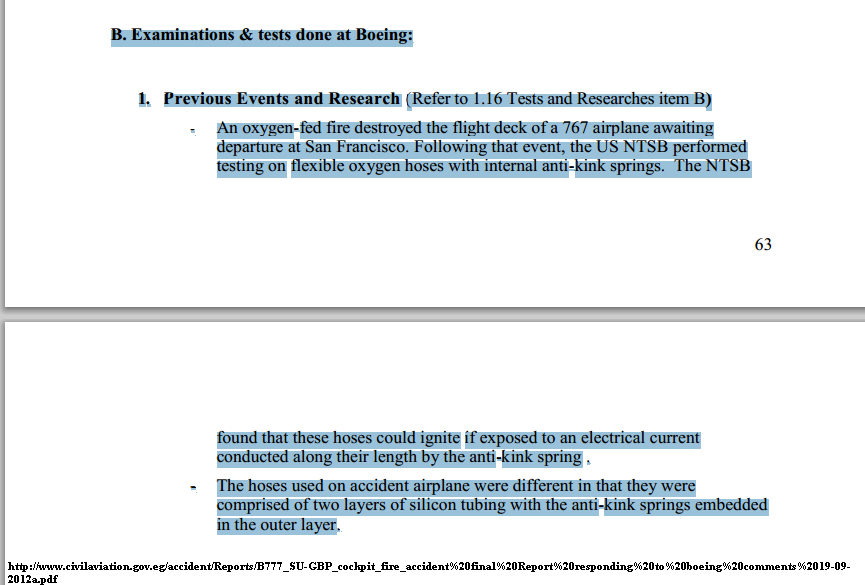(A Logical and Lateral Thinking Approach Required?) - access this (with imagery) at http://tinyurl.com/mh370-mostLikelyCause or
http://tinyurl.com/lrhentv (this page)
see also: http://tinyurl.com/ngjdd8m
Any Occam's Razor approach to the fate of MH370 would be considering the oxygen flare fire over three years ago at Cairo airport (see imagery) - as the paramount and pre-eminent clue. An Egyptair 777 was destroyed. This is particularly relevant as the FAA only got around to publishing its corresponding final rule Airworthiness Directive in mid April this year (well after MH370 disappeared) - as a means of enforcing adoption of the slightly earlier Boeing Service Bulletin. That Cairo fire penetrated the cockpit RHS sidewall. Airborne, this hull rupture would have caused a rapid depressurization - as well as quickly allowing depressurization outflow air (followed by the inflow of slipstream air) to instantly dissipate enriched oxygen levels and blow out any residual smouldering .... if it had occurred inflight at 35,000ft. After self-extinguishing, the degree of damage may have visually appeared quite nominal or minimal - except for some sooting and the pierced sidewall and one other critical aspect for aircraft control and communication (amplified below).
The image (see link or image below) of the Egyptair 777's seriously damaged cockpit indicates a worse fire than would have occurred airborne. This was because the Cairo firemen took a lot longer to intervene than would be acceptable elsewhere - and because the evacuation of personnel took priority.... so the fire took hold. However the oxy blowtorch effect of the fire's burning its way through the cockpit sidewall would've been the same in both cases (i.e. a blowtorch is a blowtorch at any height - as it is supported and sustained by its own oxygen supply). Don't confuse the sudden flare-up of an oxygen fire with the sort of fuel-fed sustained and spreading fire that brought down Swissair 111 (i.e. its fire was fed by airflows behind the cabin linings propagating fire courtesy of the highly flammable and ubiquitous MPET thermal acoustic insulation. MPET = metallized mylar). The oxygen flare fire, by contrast, can be compared to an oxygenation flash-over or backdraft experienced momentarily when unwisely opening a door in a burning building. An oxygen flare fire is a very sudden onset short duration conflagration, in comparison with (say) the Swissair 111 fire. The Swissair pilots had 15 to 20 minutes from detecting fumes to their crash. Lithium Ion battery sustained inflight fires have always had similar slow-time onsets.... as well as being very hard to extinguish.
However the MH370 pilots may have been instantly burnt alive in their seats if both had been seated at the time of a wiring short-initiated oxygen fire. Oxy fires can peak at very high lung-searing temperatures - but subside quickly. The effect upon plastic components can be distortive to the point of meltdown. It's a function of peak temperature not just exposure time. The culprit was as simple as Boeing having utilized an electrically conductive stiffener wire in the interior of the pilots' oxy-hoses (i.e. a wire-spring helically wound inside a low-pressure oxygen hose to allow it to stretch and corner without a flow-limiting collapse or kink). But the use of an electrically conductive wire permitted a chafe-induced wiring short. This conclusion was reached quickly by the Cairo investigators - but maybe the luck stopped there? One has to wonder whether Boeing's whizz-kidz considered what may have occurred if airborne. Did they model or conceptualize that possibility? Was the Boeing Service Bulletin implemented on MH370 - i.e. did they change those concertina hoses or did the S.B. merely contain a suggested inspection for any anomalies - and low-priority scheduled it for the next major servicing? Accidents tend to emphasize solutions as to causality - but once that challenge is resolved, all involved de-prioritize the remedial cures until after a "proper" cost-benefit analysis and a program of Monte Carlo "repeatability and reproducibility" processing simulations. Fixes cost money and are universally unpalatable in commercial aviation. Suggested visual inspections (for chafing, say) constitute an "easy out" means of resolution. This can be seen time and time again in Service Bulletins and their formalizing EASA and FAA airworthiness directives. The underlying weasel philosophy is always that (tongue in cheek) "prevention is better than cure". But admittedly, some cures can introduce their own indeterminate bugs.
|
There's a vast difference between a flash-over type oxygen
fire flare-up and a fuel-fed fire (such as Swissair 111).
Oxy flare fire is over and done with in a few seconds like
the one that destroyed the cockpit in P3B A9-300 on the
ground at RAAF Edinburgh in the early 80's, only slightly
injuring the technician because he was only just starting to
fill the bottles from an external cart. That was nailed down
to the stupid use of lubricants causing spontaneous
combustion. As with all such fires (i.e. per Cairo's
Egyptair 777), the on-ground version is always worse because
of the time taken for the firemen to appear and
intervene..... and the consequential airflows are different.
Airborne at 35,000ft, it would be a quick flash-over of 5 to
15 seconds and a blowtorch rupture of the hull and
depressurization outflows followed by oxygen enrichment in
the cabin dissipating suddenly. The residual would be the
scorching melt of many plastic push-buttons and the
fire-quenching slipstream inflows of very "thin" air - and
then some residual smouldering of plastics (including
pushbuttons). Why? because they'd be out of the way of the
slipstream inflow on the centre pedestal and overhead
console. Remember that the outward hull-piercing
depressurization might lead to an air-scooping lip for inlet
slipstream airflows. i.e. high-speed air would be drawn in.
The Swissair fire started slowly and got fanned sight
unseen beneath the cabin linings by the pilots running the
checklist and (eventually, by them turning off the recirc
fans), allowing the fire to propagate forward. An oxy flare
fire is an entirely different scenario altogether to a fire
fed by (say) highly flammable thermal-acoustic blankets
throughout the airplane.
That's the point being missed - together with the fact that
the Service Bulletin was untimely, inadequate and didn't
mandate anything more than a regular inspection (and the FAA
AD didn't come out until mid April 2014). In my mind, it all
adds up to a lot of people now keeping their fingers crossed
that nothing conclusive ever be found.
|
|
There's fires and there's "fires" |
See the links below for discussion of the ramifications of an inflight oxygen fire. Most significant amongst these is the effect that such a fire would have upon the type of pedestal mount, glareshield and overhead console plastic pushbutton and rotary switch controls that you find in modern aircraft. These plastic pushbuttons and their recess surrounds can quickly melt differentially, distort and become non-functional in highly elevated temperatures of as little as 10 to 15 seconds exposure (the rough duration of an oxygen flare-up fire). By comparison, the metal toggle switches of yesteryear would've been relatively invulnerable to any such flash fire. Meltdown in a brief duration oxy flare fire was never factored into plastic pushbutton ops.
Note also that some switches are momentary contact (such as an R/T push-to-talk), some are electrically or mechanically latched by button depression (ON/OFF), others are rotary and some may function via permitting a pull-in solenoid to complete a permanent ground to an earth. Other types may be spring-latch released, fused together by a fire or even actuated (such as in a keypad's partial meltdown). It's a complex matter sorting out which pushbutton and its parent system would be affected (i.e. which systems would be activated, which de-activated and which would simply be rendered inoperative (i.e. disempowered) or just made inoperable)..... by a plastic pushbutton melting and/or any distortion of its housing. Much would depend upon the plastic pushbutton's distance from the seat of the fire and any intermediate shielding effect. It's an imponderable one that's not yet been a known factor in a modern day aviation incident or accident. Plastic meltdowns have (to-date) been incidental and noteworthy - but not causative when considering "ghost flight" instances.
Why would such an oxygen flare fire occur just when it did? We can imagine the following credible scenario:
a. Top of Climb (or just after, and settled down in the cruise in friendly weather) is a non-busy time for the captain to go down the back for a toilet or rest break. There are few distractions or ATC concerns once in the cruise phase. This personal routine could be individually confirmed as being the MH370 captain's typical modus operandi by querying other first officers with whom he'd flown the Beijing (and other) routes.
b. Having made his final call to Kuala Lumpur, the captain would push his seat back, unstrap and announce to the first officer that he was going aft. The F/O would acknowledge and take his oxygen mask out of its housing and don it as the captain proceeded aft, closing the flight-deck door behind him. Why would the F/O don his mask? That is Standard Operating Procedure globally whenever one pilot is left on the flight deck alone.... for obvious reasons.
c. Having donned his oxy-mask, the F/O would do as just instructed (by KL ATC), i.e. switched to his oxy-mask mike, switched frequency and called Ho Chi Minh City ATC. That call would not have gone out if either the oxy-mask mike switching (from lip-mike) or his R/T transmission had triggered the oxygen flare fire.
d. Either the microphone-switching or the transmission itself (or an F/O's oxy regulator selection) could have triggered the oxygen flare but whether or not the timing meant that the captain was still within the flight-deck might be inconsequential. Once out of his pushed-aft seat, he'd have been partly shielded from the flare and after it had subsided (about 5 to 15 seconds), he'd have had time to pre-select the heading to Pulau Langkawi thereby initiating the turn-back - before himself passing out due to hypoxia. For the pilots, an oxygen flare fire is a double "gotcha".... if the blowtorch effect ruptures the pressure hull.
e. The drop-down masks would've enabled the passengers to survive for ten to 15 minutes at FL350, however walk-around bottles would have enabled Flight Attendants some further period of consciousness. Whether they'd have been able to regain entry to the flight-deck and effect a much later course-change? Possible, even probable...... that the later course change to a Southern I.O. heading would've been within the limits of duration of their portable oxygen bottles. Flight attendants delivering food to the flight-deck would've been familiar with seeing the knob that pilots would rotate to make a heading alteration.
f. In another interpretation of the aftermath of such an oxy flare-fire, the captain may have regained his seat after the flare had subsided, disconnected the autopilot and donned his mask (not fully realizing that the flight-deck oxygen supply had been compromised). If the captain had dialled in a heading, then lowered the nose but not manually trimmed nose-down, when he soon passed out due hypoxia and relaxed is nose-down pressure on his yoke, the aircraft at its higher speed would have zoom-climbed up to 40,000 feet then dropped its nose (purely per the aerodynamics of such an event) and eventually regained wings-level flight at some lower altitude (approximating their original cruise altitude). Why would he not have trimmed nose-down? Pilots in modern airliners are used to CWS (and its pitch-axis auto-trim). CWS is "control wheel steering". The manual trim wheel doesn't come naturally to mind for requiring manipulation.... but "stuffing the nose down and getting to an oxygen friendly altitude" is beaten into their brains in simulator sessions as second priority to getting their oxy-masks on. Aviate/ Navigate/Communicate. It's likely that communication was the last thing to come to mind - as hypoxia intervened.
Whatever the sudden cascade of disruptions to MH370's systems may have been, they can best be explained by the predations of an oxygen flash-fire. It is likewise unsurprising that a ghost flight would be the consequence of such an event - due to either the death/incapacitation of the pilots, the inability to control or communicate (due melted pushbuttons and fire-crazed and sooted displays or obscured LED read-outs) ..... or simply the very restrictive time of useful consciousness once depressurization occurs at 35,000 feet (i.e. a T.U.C. that is measured in mere seconds). However one of the seated pilots (or one re-entering the flight-deck with a portable oxy-set) may have been able to pre-select a roll-out heading for Pulau Langkawi (nearest available airport) before ultimately succumbing to hypoxia or injury. MH370's subsequent southbound flight path may easily have been a consequence of an interim flight upset near the tip of Sumatra caused by flight through a cumulo-nimbus cloud-top. Who's to know? But it can't be ruled out as a course-altering explanatory mechanism. The position (latitudinally) on 08 March of the ITCZ band may be a clue here (see http://tinyurl.com/qj7djvf).
| Sudden Oxy flare fire may have given an injured LH
seater time to dial up a pre-select heading for Pulau
Langkawi before he passed out from hypoxia. The autopilot
may have died latterly due to a smouldering fire (following
pierced sidewall inflows) allowing further console damage /
melting plastic buttons and switches (smouldering centre
pedestal being forward of a hull rupture inlet airflow
adjacent to the RH seat, some smouldering may have
persisted). Subsequent events/ significant course changes may have been attributable to an aircraft flying without autopilot recovering after "encounter upsets" with high-level CumuloNimbus tops.... (courtesy of the 777's active flight control's inherent stability and ability to quickly (over a relatively few minutes) regain Straight & Level flight via diminishing phugoid activity- i.e. any porpoising up and down for a while in pitch attitude will soon dampen itself out) - i.e. there's a limit however to what will happen re regaining aircraft original heading after an upset - i.e. it could alter heading by 90+ degree easily after any such upset. However the aircraft will, courtesy of its inherent stability and pre-fire locked trim state, regain straight and level flight after some oscillatory interim phase..... ultimately climbing much higher on its new heading, due to due fuel burn-off and its fixed trim state. Think of the ITCZ latitude in March and CumuloNimbus cloud tops extending well above 40,000 feet,,,. within that ITCZ latitude band. Quite likely that the aircraft (with all aboard dead) would have flown through a few thunderheads and ultimately ended up on an undisrupted (clear air, smooth flight) southerly heading due to its clearing the ITCZ's band and ultimately being well above most southern hemisphere/equatorial CuNim tops - due to its fixed trim state and a fuel burn-off based climb. |
|
Unexplained Heading Changes - explanations |
The impact of a functional or non-functioning autopilot is discussed in the links below. Even if the autopilot was knocked out (or deselected by the captain attempting an emergency descent), the 777 comes with an active flight control system. What this simply means is that, in the absence of significantly disruptive turbulence, a 777 flying autopilot OFF will quickly pick up a dropped wing and thus maintain a fairly consistent heading ad infinitum. Even after an encounter with a CB, the 777 would have the inherent stability to dampen its phugoid oscillations in pitch and settle down to a substantially consistent, trim-compliant flight-path and steady pitch attitude. Unaffected by pax or F/A movement up and down the cabin, the lack of a continually moving compensating trim would permit a quite consistent pitch attitude in relatively smooth air. Likewise it will (if the auto-trim is inert) climb gradually at a fixed pitch-trim setting - as fuel is burnt off.
This scenario in its entirety was addressed earlier in the links below. It represents one possible/probable/ but likely scenario for the unknown sudden events aboard MH370..... and its later onwards "ghost" flight to fuel exhaustion. Any presumption of an earlier splashdown due to a higher fuel consumption at a lesser/lower level than Flight-Level 350 is likely incorrect. If the "ghost flight" proceeded as depicted above, then the aircraft would have progressively climbed very fuel-efficiently to higher altitudes and achieved at least the "book" air nautical miles per pound fuel consumption. This ANMPP rate would place its fuel exhaustion point much further south than the amended search area that contained the (now) discredited ULB pinger contacts.
I consider this interpretation of Flight MH370's enigma flight to be more feasible than any other dissertation I have yet seen. There is precedent. Sometimes the explanation for a mystery can be elusive. In this instance it is rooted in a simple extrapolation of a prior well-inestigated tarmac event - but one with unconsidered airborne complexities.
regards (and not for nominal publication)
John S
ex Editor in Chief of Air Safety Week (PBI Media)
and veteran P3 Orion pilot (RAAF, RAF, RSAF, BAe)
0414 766158
Airworthiness Directive
Final Rule as a result of the Egyptair 777 on-ground fire at Cairo was
only released by FAA a few days ago (i.e. the initiating ramp incident
was in Cairo to an Egyptair 777 over three years ago).
"We are adopting a new airworthiness directive (AD) for certain Boeing
Company Model 777F series airplanes. This AD was prompted by a report of
a fire that originated near the first officer's seat and caused
extensive damage to the flight deck. This AD requires replacing the
low-pressure oxygen hoses with non-conductive low-pressure oxygen hoses
in the stowage box and supernumerary ceiling area. We are issuing this
AD to prevent electrical current from passing through an internal,
anti-collapse spring of the low-pressure oxygen hose, which can cause
the low-pressure oxygen hose to melt or burn and lead to an oxygen-fed
fire near the flight deck.
UNIFIED AGENDA
Airworthiness Directives
1 action from October 2014"
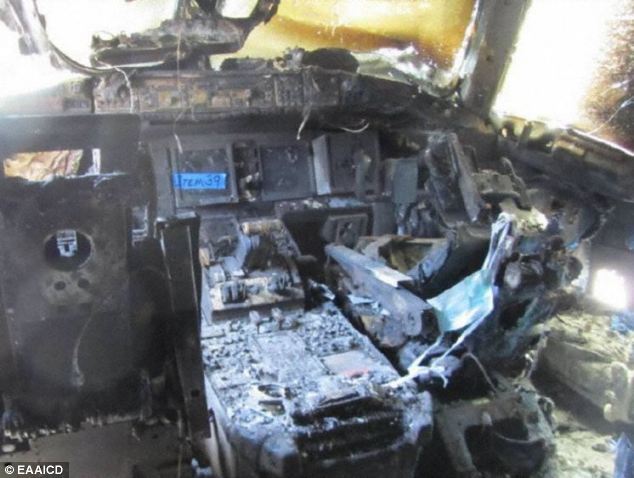 |
Aftermath of Egyptair 777 oxygen flare cockpit
fire at Cairo.
The degree of destruction was much worse than could be expected from an airborne fire - as the ongoing on-ground fire was only extinguished after a protracted delay (poor comms, belated firecrew attendance and the priority being given to evacuation of personnel). The inflight consequences may have been much different in terms of damage and flare duration.... because of pressurization and environmentals (atmospheric pressure and the much reduced oxygen content of high altitude ambient air inflows following depressurization). Different switches will behave differently in response to different degrees of a quickly peaking and diminishing flare-heat exposure – as will (vitally) circuit-breakers on overhead and side-panels. Remember that circuit breakers are tripped thermally (i.e. contain bi-metallic strips that will all have different amperage tolerances and thus trip at different times during or after an oxy flare-fire). Tolerances is what that game is all about. |
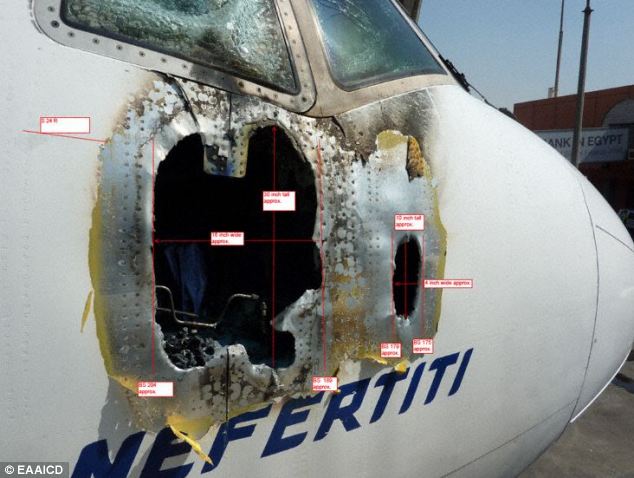 |
An airborne oxygen flare fire would be quickly
extinguished by the blowtorch penetration of the cockpit
sidewall, the consequential depressurization outflow, dilution
of the oxygen-enriched flight-deck air and the
subsequent inflow of thin (low oxygen content) high-speed slipstream air.
Arguably, any inflight established oxygen flare could also be suppressed somewhat (initially) by the cabin pressure (i.e. it's more difficult blowing into an already well-inflated balloon). But note also that penetration of the blowtorch-weakened sidewall would be assisted by the higher cabin pressure differential.... creating an earlier hull rupture and an earlier "out" for the cockpit fire. The blow-out might even create an airscoop effect (i.e. a hole with different extrusion characteristics to the image here). As a precautionary measure, perhaps the system needs a flow-rate limiter further upstream in the pilots' oxy system.
|
| Some FAQ's Answered | |||||
|
Course and altitude adjustments. Turnback would’ve been pilot-initiated (probably by the captain returning to the scorched and smoking flight-deck following the oxy-flare fire). That would’ve been urgently accomplished by him via the pre-set heading bug. The initial zoom-climb is adequately explained in the document. Captain (down back for a leg-stretch or a leak) would’ve rushed back to “the office”, opened the door and seen a scene of scorched seats and pedestals and (likely) a dead or dying co-pilot. My guess is that the flare having subsided to a few smouldering areas, the captain may have resumed his (scorched) seat and wound in a turnback heading for Pulau Langkawi on the heading bug – prior to then entering an emergency descent….. once it became apparent that they were losing pressurization due to the oxy blowtorch on the copilot’s side console. That is a presumption that the oxy blowtorch burn-through of the copilot’s hull sidewall had happened earlier but with the hole only just reaching the size where pressurization was being lost (see relevant Cairo image).. Captain, due shock and surprise, may have even donned his oxy-mask once realizing that a depressurization had commenced, BUT (no oxygen being available) he would have passed out soon after entering a manually flown descent. I explained in the document all these aspects but I also pointed out that 777 pilots aren’t used to manually trimming via elevator trim during the little encountered manual flight mode. This is what killed the Air NZ A320 crew out of Perpignan a couple of years back. They’d have survived if they’d used the manual elevator trim (i.e. wound it forward) to afford sufficient elevator authority to exit their very nose-high attitude. But they were insufficiently aware of that secondary control….. it not normally being used due to the auto-trim being on the job 99.99% of the time. Unfamiliar is unaware. In the MH370 case, the captain would’ve manually stuffed the nose down via a yoke input for the emergency descent (which normally involves selecting the nose-low attitude and only then retarding the power/deploying speedbrakes once the speed has increased). But with a time of useful consciousness of only around 15 to 20 seconds at cruise height, the Captain likely passed out, relaxed his forward pressure on the yoke and consequently, the aircraft response to that higher speed (for which it wasn’t pitch-trimmed) would’ve been to pitch up and make 40,000 feet before (once approaching stall speed) pitching down and ultimately returning to its trimmed airspeed at around the prior cruise-height. The turn onto a Southerly Indian Ocean heading from above the tip of Sumatra has two possible explanations. If the aircraft was NOT on autopilot, it may simply have been due to it encountering a thunderhead and being spat out of that upset on a southerly heading (my guess). In the vicinity of the ITCZ band, the Cumulo Nimbus can reach up to 50,000 feet. Further south of the equator, anything above 30,000 feet would be rarer at that time of year, so southbound flight would have been increasingly much smoother….. with no thunderhead encounters (and only the drag from a RHS hull rupture causing a bias in its course to the right – thus the arcing track). The other explanation may be related to the F/A’s , running short of oxygen from their walk-round bottles and accessing the flight-deck and turning the heading pre-set bug onto where they thought KL or Penang might be. In the document I’ve described how the 777 sports an “active control” flight control system. Whereas any normal airplane might enter a spiral and not survive once pilotless, the active control system is immediately compensatory (i.e. drop a wing due to turbulence and it’s picked up immediately - if it’s not due to a pilot’s yoke input). You end up with steady wings-level flight and a quite stable heading because of that. It would’ve had a stable unchanging pitch-trim state and the only resultant would’ve been a gradual but very fuel-efficient climb as fuel burnt off (which would’ve put splashdown much further south than the latter search areas containing the pseudo-pings). Significant heading changes may have been due to F/A flight deck access prior to exhausting their oxy bottles or due to thunderhead encounters. These latter hdg changes may have induced upsets in heavy turbulence that resulted in height and heading changes. I can’t make it any simpler than that. F/A’s would’ve been familiar during food deliveries to the flight-deck with the simple method pilots used to wind in hdg changes. But my bet is that after the attempted emerg descent all flight thereafter was minus the autopilot.
b. Explosion/fire Don’t think explosion/fire whatsoever. In an oxygen flare “fire” it’s just a sudden flare-up which melts some plastic push-buttons and their housings, trips Circuit Breakers, scorches surfaces and sears the lungs of anybody on the flight-deck. Plastic push-buttons can fail in many different ways. i.e. some will earlier and some latterly depending upon how far they are from the flare, and how exposed they are directly AND how a particular switch operates (refer to my earlier document). It’s an aspect of modern PLASTIC push-buttonry that has never been considered in depth (i.e. their propensity to melt, fail systems and become non-functional in such circumstances). Some molten or housing-distorted buttons won’t turn off systems when pushed – and some will. Some will self-actuate due the heat. It depends upon how a particular switch works (see main document). So everything won’t fail all at once – and some systems won’t be affected at all.. The residual smouldering would be poorly sustained once the oxygen-enriched environment transitions to a very thin oxygen content i.e. after the hull is ruptured and the aircraft is fully depressurized (not to mention the gale blowing in via any significantly sized hole – that’d likely have outward-projecting lips acting as air-scoops). I doubt that any sat-phone would be available/remain serviceable – or that an MH F/A would have a clue how to operate it, even if it was. I’d also suspect that once the pax drop-downs ran out, the F/A’s may well have been sharing their oxygen (or having it taken from them via panicky pax). Use of R/T? First up, you need to know the frequency that’s within range (and LED read-outs would’ve been quite sooted up anyway, if not crazed and melted).
c. “And, if the jet was on fire, why did it keep on flying for hours?“ An oxy flare-fire can scorch and cause plastic to melt and smoulder and they peak out at quite high temperatures for a very short period (less than a minute/more like 10 to 15 seconds)…. before subsiding almost completely leaving lotsa scorch and some smoulder. Once the oxygen flow has exhausted, it’s no more a “fuel-fed” fire than tipping a bucket of water over your head can be called a flood. Talk to a fireman about oxygen flash-fires. It’s similar to the momentary backdraft you can get by unwisely opening a door in a burning building. It’s a nasty deadly flare and nothing more. The only reason the Cairo 777 fire’s imagery looks as bad as it does is that the Cairo firemen took ages to turn up, the fire was allowed to take hold. The results of the hull rupture on the ground at Cairo would’ve borne almost nil resemblance to what would’ve happened as a result of the outflow/then inflow through a hull-hole airborne at cruise height.
d. “Were the Malaysian Govt failures to intercept the radar blip just a screw-up?” It’s quite difficult to keep a radar operator on the ball, staring at a primary radar screen when he’s got no ATC separation and guidance function to perform. He’s looking at a lot of static and ground returns and needing to do that (effectively) by adjusting tilt, antenna rotation rate, range-scale and PRF, Pulse width etc etc. It’s boring stuff that I used to do on Neptunes and Orions whenever flying as pax or not in the bunk or pilot-seat. The military radar watch in peacetime tends to be very perfunctory unless somebody is there cracking the whip. Detections via primary radar can only be assumed to be a particular target if it is correlated via identifying turns, communicated headings, matching visual positions communicated etc. Radar height-finding is also very haphazard and inaccurate. It always helps if you know that there’s a target to be looking for (otherwise it’s just another boring night sitting in front of a scope, reading a comic).
e. “Was the MH370 777 jet oxygen supply fixed in accordance with the FAA directive?” First comes the Boeing Service Bulletin (which may have been pursuant to the investigation’s interim report) – i.e. around 3 years later.. The FAA Directive (final Rule) came out in mid April 2014 well after MH370 disappeared. It would have simply made mandatory (for US aircraft) the Service Bulletin resulting from the loss of the Cairo 777. That S.B. may well have been an early 2014 document (date of the S.B. is usually given in the FAA Directive). However Boeing considers S.B.’s proprietary and no-one but addressees are allowed access to the content. 90% of these S.B.’s are “ inspect for “xxx” and report”. i.e. They claim to need data to justify the cost-benefit of any mandated expenditures by Boeing or loss of in-service use for modifications by the airlines. So an inspection (for chafing etc) is usually either merely “recommended” or ultimately mandated for the next major service.” Following the 2011 blaze, US aircraft owners were instructed to replace the system - it was estimated to cost $2,596 (£1,573) per aircraft. It’s not known whether Malaysia Airlines had carried out the change.
I’ve now been permanently banned from Pprune, so that may give you an idea how keen the powers-that-be are to suppress any such expanded theory (having bought Pprune.org for that purpose).
|
|||||
| The Cairo Egyptair 777 Cockpit Oxygen Fire - SU-GBP | |||||
|
|
See the attached image below. I'm banned from Pprune.org (sob). They've now made it permanent.
They are just so arrogant. But then again they only operate Pprune on behalf of its new owners - and Pprune is not the only site they censor. Why? Because that is their function and business plan.
What do they have to hide and on whose behalf? I think the answer is evident....and evidently they are also spying on private emails as well.
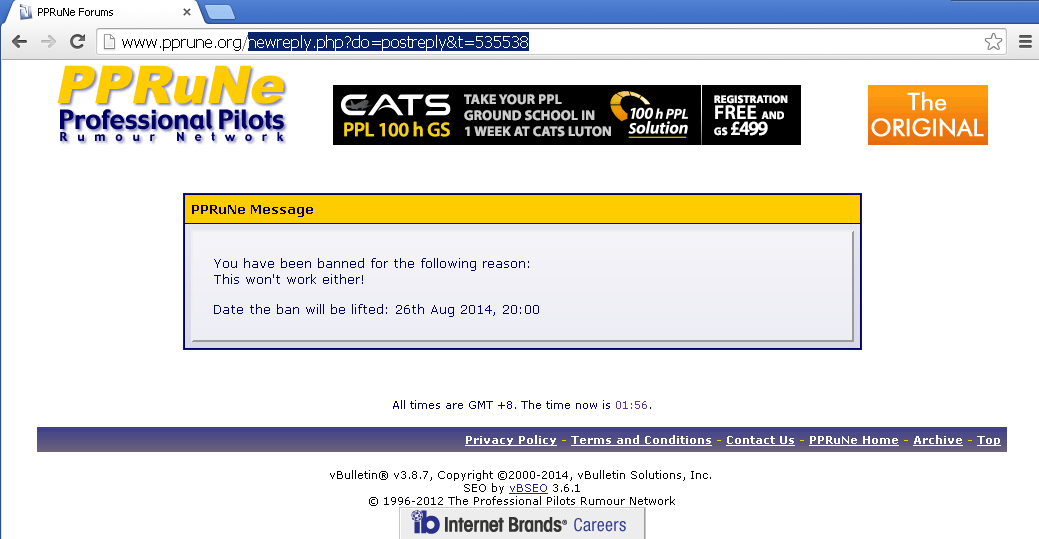
Pprune's [proxy operators] - their task is to protect and delete ( delete what? Anything their airline industry masters don't want to appear (and be read by the public) on this widely read pilots form)
"Internet Brands is the leading provider of website satisfaction and reputation management services."
Having read my "deleted" post above, you'd possibly agree that "killing it off" would've been a quite high priority for these suppressor "under-cover" operatives.
http://www.pprune.org/8484852-post10790.html (ditto the link to the online off-Pprune copy at http://tinyurl.com/lrhentv )
